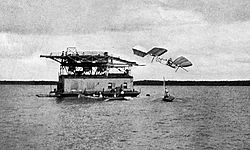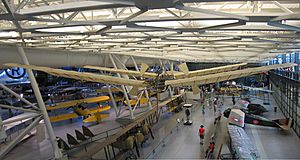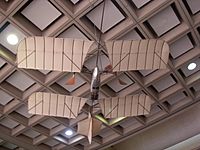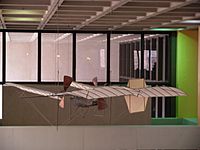Langley Aerodrome facts for kids
Quick facts for kids Langley Aerodrome |
|
|---|---|
 |
|
| First failure of the manned Aerodrome, October 7, 1903 | |
| Role | Experimental, pioneer fixed-wing aircraft |
| National origin | United States |
| Designer | Samuel Langley |
The Langley Aerodrome was an early flying machine designed by Samuel Langley. He was the head of the Smithsonian Institution at the end of the 1800s. This aircraft had a special design called a tandem wing, meaning it had two main wings, one behind the other.
Langley's goal was to create a powered aircraft that could carry a person. The U.S. Army gave him $50,000 in 1898 to work on the project. This happened after he successfully flew smaller, uncrewed models a couple of years earlier.

Contents
Designing the Aerodrome
Samuel Langley created the word "Aerodrome" for his flying machines. This word comes from Greek words that mean "air runner." He used it for many aircraft he built with his team at the Smithsonian. These included both uncrewed models and the larger, crewed versions.
Langley started testing his uncrewed models in 1894. After some tries, his steam-powered model "Number 5" flew successfully on May 6, 1896. It flew for 90 seconds, covering over 0.5 miles (0.8 km) at about 25 miles (40 km) per hour. It reached a height of 80 to 100 feet (24 to 30 m).
In November of the same year, model "Number 6" flew almost 1 mile (1.6 km). Both aircraft were launched from a houseboat on the Potomac River in Virginia. These flights impressed Theodore Roosevelt, who was then the Assistant Secretary of the Navy. He thought the machine "worked" and suggested the U.S. Navy look into it.
The U.S. Department of War later gave Langley $50,000. This money was for building a full-size Aerodrome that could carry a person. Langley's team also built a smaller, quarter-scale model powered by gasoline. This model flew successfully twice in 1901 and again in 1903.
First Flights and Challenges
The full-size Aerodrome had a powerful engine. It made 53 horsepower, which was about four times more than the engine the Wright brothers used in their first plane in 1903. However, the Aerodrome's design had some big problems. Its structure was not strong enough, and its control system was very basic. It had a tail shaped like a cross and a rudder in the middle.
Langley planned to launch the Aerodrome from a houseboat using a catapult, just like his models. He chose his chief engineer, Charles M. Manly, to fly the aircraft.
The first flight attempt was on October 7, 1903. The Aerodrome failed to fly and immediately fell into the Potomac River after launch. Manly was pulled out of the water safely.
The second attempt was on December 8, 1903. This time, the aircraft broke apart right after launch and again crashed into the river. Manly was rescued unharmed once more. Langley blamed the crashes on the launch system. However, the real issues were with the aircraft's weak structure and its poor control system. After these failures, Langley stopped his tests. His experiments became a target for criticism in newspapers and in the U.S. Congress.
Just nine days after Langley's second failure, the Wright brothers made four successful flights in Kitty Hawk, North Carolina.
Later Modifications and Controversy
Years later, in 1914, the Smithsonian Institution asked Glenn Curtiss to work on the Aerodrome. Curtiss was an aircraft designer. The Smithsonian wanted to show that the Aerodrome could have flown. They also hoped to challenge the Wright brothers' patent on aircraft design.
Curtiss made many changes to the Aerodrome. He made the wings smaller and stronger. He also changed the tail to work in a more common way. He improved the engine and added new propellers. To allow it to take off from water, he added floats and lowered the aircraft's center of gravity.
Curtiss made a few short "hops" in the modified Aerodrome in 1914. None of these lasted more than a few seconds.
Based on these short flights, the Smithsonian displayed the Aerodrome in its museum. They claimed it was the first crewed, powered aircraft "capable of flight." This upset Orville Wright (his brother Wilbur Wright had died in 1912). Orville accused the Smithsonian of twisting the history of flight. As a protest, he refused to give his original 1903 Wright Flyer to the Smithsonian. Instead, he donated it to the Science Museum (London) in 1928.
The disagreement finally ended in 1942. The Smithsonian admitted the changes Curtiss had made to the Aerodrome. They also took back their claims about the aircraft.
Curtiss called his work a "restoration," saying he only added pontoons for water testing. But critics, like patent lawyer Griffith Brewer, called them major changes. Brewer asked why, if the Aerodrome was a practical flying machine, it wasn't flown without changes. He also questioned why someone found guilty of patent infringement was chosen to prepare the historic aircraft.
Curtiss flew the modified Aerodrome from Keuka Lake, New York. He lifted a few feet off the water several times, for no longer than five seconds each time. Photos showing daylight under the pontoons were published in the media.
Preservation of the Aerodrome
Two of Langley's smaller model Aerodromes still exist today.
- Aerodrome No. 5, the first Langley aircraft to fly, is at the National Air and Space Museum in Washington, D.C..
- Aerodrome No. 6 is at Wesley W. Posvar Hall, University of Pittsburgh. Engineering students helped restore it. Only the fabric on the wings and tail is new. Some parts were rebuilt using old wood from the same time period. Langley used to be an astronomy professor at the University of Pittsburgh before joining the Smithsonian.
The full-size, man-carrying Aerodrome also survived. After Curtiss rebuilt and tested it, Smithsonian staff changed it back to Langley's original 1903 design. It was a place of honor in the Smithsonian museum until 1948. That's when the original 1903 Wright Flyer came home from the UK.
Afterward, the Aerodrome was kept out of public view for many years. Today, it is displayed at the National Air and Space Museum's Steven F. Udvar-Hazy Center in Chantilly, Virginia.
See also
 In Spanish: Langley Aerodrome para niños
In Spanish: Langley Aerodrome para niños



